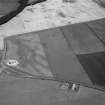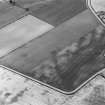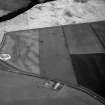Inchbare South
Pit Defined Cursus (Neolithic), Rig And Furrow (Medieval) - (Post Medieval)
Site Name Inchbare South
Classification Pit Defined Cursus (Neolithic), Rig And Furrow (Medieval) - (Post Medieval)
Alternative Name(s) Inchbare 1; Stracathro
Canmore ID 35972
Site Number NO66NW 41
NGR NO 60900 65550
NGR Description From NO 6077 6549 to NO 6101 6560
Datum OSGB36 - NGR
Permalink http://canmore.org.uk/site/35972
- Council Angus
- Parish Stracathro
- Former Region Tayside
- Former District Angus
- Former County Angus
NO66NW 41 60900 65550
NO 608 655. Enclosure (Site), Inchbare: A remarkable palisaded enclosure, bounded by a single line of pits as for timber uprights, enclosing an area estimated at 23 to 30m in width by 200 to 240m in length, is visible on aerial photographs. Further short lines of post-pits are apparent to one side of the enclosure, and a number of larger spots where the crop is taller than average appear at the opposite side. (see NO66NW 49) The period (? Dark Age is suggested) and significance of these structures can only be revealed by excavation; they relate to no modern farming practices.
A number of curving broad lines also visible on the photographs represent traces of rig-and-furrow cultivation, the ridges now being levelled.
J K St Joseph 1976.
A review of the evidence now suggests that the palisaded enclosure, measuring approximately 300m by 20m, is possibly a pit-defined cursus.
H L Winton (RCAHMS) 25 March 1992.
Note (1983)
Inchbare South NO 609655 NO66NW 41
Cropmarks reveal three parallel lines of pits running WSW to ENE across the field to the SE of Inchbare. Two of the lines of pits, which extend for a distance of at least 300m, are set 20m apart, and unite at the WSW end in a square terminal; the third line lies about 10m to the SSE. Immediately S of the WSW end there are traces of a rectangular pit-defined structure measuring about 20m by 9m internally.
RCAHMS 1983.
Aerial Photographic Transcription (1 June 1992 - 4 June 1992)
An aerial transcription was produced from oblique aerial photographs. Information from Historic Environment Scotland (BM) 31 March 2017.
Note (January 2017)
Enclosing space
From the beginning of the Neolithic period communities built monuments which enclosed space on a scale never before seen in Scotland. Amongst the earliest and largest are cursus monuments, so-called because when first identified in the 18th century they were thought to be Roman chariot racing arenas. It was not until the 20th century that excavation and dating showed them to be of Neolithic date. So what are these strange named monuments? Well, cursus monuments are long linear enclosures, often measuring up to several hundred metres in length, which were built of large timber posts or a ditch and bank. Although we group them all under the one name ‘cursus’ the different materials (timber and stone) represent two distinctly different, though probably related, forms of monument built at different times during the Neolithic period. Those built of timber posts were constructed during the earliest centuries of the Neolithic, probably between 3900 and 3600 BC, while earthwork (or ditch and bank) cursus monuments were built slightly later, between around 3600-3000 BC. Intriguingly wooden cursus monuments, the earliest dated cursus form, have been found only in Scotland while the others were built throughout the whole the British Isles. So, as far as we know at present, timber cursus monuments are a uniquely Scottish phenomenon.
Impressive monuments
As a whole cursus monuments are largely to be found in the east and south of Scotland. The upstanding elements of most have long gone, either decayed and disappeared or been levelled out by repeated ploughing. We are able to identify these monuments through cropmarks recognised and photographed through aerial survey, the colours and patterns in crops showing the outline of post-holes or ditches defining these large enclosures. Examples include a large timber cursus at Inchbare South in Aberdeenshire (showing on aerial photographs as lines of post-pits; each pit would have held a timber) or the shorter, but equally spectacular timber cursus at Mill of Fintray. Earthwork cursus monuments are often on a much larger scale than the earlier timber variety and some, such as the cursus at Drybridge in Ayrshire, are so long that their full length has not been recorded. The earthwork cursus at Holywood South in Dumfries and Galloway gives an idea of what the plan of larger examples may have been like. But even this, at 285m in length, would have been a massive monument.
In their heyday these would have been very large and impressive monuments. Imagine enclosures defined by towering timber posts, or large ditches and banks enclosing enormous spaces in the landscape. We know from excavations at a selection of these sites that communities used cursus monuments for ceremonial or ritual activities. At some timber cursus monuments, for example, there is evidence for repeated activity suggesting that people were returning to these monuments at intervals, and in some cases selecting individual posts of the boundaries to burn or to pull out and replace. The boundaries of both forms of cursus monuments often seem to be wobbly or irregular suggesting they were built in sections, perhaps by different groups or communities or over a period of time. Cursus monuments were impressive places forming important enclosed spaces throughout the Neolithic period. For the communities that built them, this was a new a way of shaping place and space, of expressing values and beliefs and of making their mark on the world around them.
Kirsty Millican - Designations Officer
































































